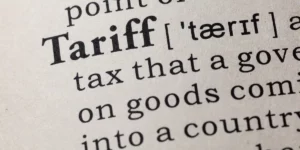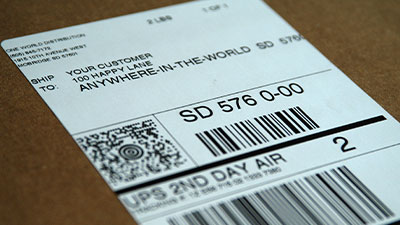One of the most frustrating, complex, and important subjects to master in logistics and ecommerce is tariffs. Simply put, a tariff is a fee or tax imposed by governments on imported or exported goods. These fees can significantly impact the cost of products as they move through global supply chains. 2025 there could be some profound changes due to the potential Trump tariffs.
As President Donald Trump prepares to implement sweeping changes to trade policy, his proposed tariffs are poised to significantly impact ecommerce businesses. These tariffs, which include a general 10-20% increase on all imports and sharply higher rates for specific countries, could drive up product costs and disrupt supply chains. With potential tariffs as high as 100% on goods from China and Mexico, understanding the new tariff structure is essential for ecommerce businesses to stay competitive and manage costs.
For businesses and consumers involved in logistics and ecommerce, it’s important to understand how tariffs work. Here’s why:
In this article, we will explore how tariffs work, the different types, and their effects on international trade. We’ll also look at real-world examples like Apple’s experience to provide practical insights. For businesses heavily reliant on international suppliers, the impact could extend beyond pricing. Delays in sourcing materials, navigating complex compliance requirements, and reassessing supply chain logistics are additional hurdles to overcome.
However, this evolving landscape also presents opportunities. Ecommerce brands can explore diversifying their supplier networks, investing in domestic manufacturing, or focusing on value-driven marketing to differentiate their offerings and stand out. Position yourself for growth in a post-tariff environment and dive deeper into how ecommerce businesses can minimize risk, optimize operations, and maintain customer loyalty amid rising import costs.
 A tariff is essentially a financial charge or levy imposed by a government on imported goods. It serves as a tool to regulate international trade, often designed to protect domestic industries from foreign competition, encourage local consumption, or generate revenue. Imagine purchasing an imported smartphone; the added cost on top of its base price due to a tariff is what you pay as part of import duties.
A tariff is essentially a financial charge or levy imposed by a government on imported goods. It serves as a tool to regulate international trade, often designed to protect domestic industries from foreign competition, encourage local consumption, or generate revenue. Imagine purchasing an imported smartphone; the added cost on top of its base price due to a tariff is what you pay as part of import duties.
While both tariffs and taxes result in increased costs for consumers and businesses, they serve different purposes:
It’s crucial to distinguish between tariffs and taxes as they impact pricing strategies in logistics and ecommerce differently.
Understanding how tariffs work is important for anyone involved in logistics and ecommerce. Tariffs are taxes imposed on imported goods to make foreign products less competitive than domestic ones. Explore how tariffs are implemented and who ultimately pays for them.
Here’s a breakdown of how tariffs are implemented:
When considering “who pays for tariffs,” it’s essential to note that while businesses initially pay these duties, the cost often trickles down to consumers through increased product prices. This impacts both the availability and affordability of goods in the market.
Several parties are affected by tariffs and may end up bearing their costs:
Definition and Purpose: Import tariffs are taxes imposed on goods brought into a country. These tariffs serve multiple purposes:
Real-World Example: The United States has historically levied import tariffs on steel to protect its domestic industry. Local manufacturers gain a competitive edge by imposing higher costs on foreign steel.
Definition and Purpose: Unlike import tariffs, export tariffs are taxes levied on goods leaving a country. These are less common but can be applied to regulate the supply of essential commodities or raw materials.
Simple Explanation: Export tariffs might be used by countries rich in natural resources. For instance, an oil-producing nation may impose an export tariff to control domestic fuel prices or ensure sufficient supply for the local market.
Understanding the impact of trade agreements is crucial for navigating international trade tariffs. The General Agreement on Tariffs and Trade (GATT) and various Free Trade Agreements (FTAs) are two major pillars in this arena.
GATT, established post-World War II, laid the foundation for modern international trade by promoting fair trade practices. It aimed to reduce trade barriers and create a level playing field through binding commitments from member countries. GATT’s influence extends to:
FTAs are bilateral or multilateral pacts that eliminate tariffs, quotas, and preferences on most (or all) goods between signatory countries. These agreements significantly impact tariff rates:
Trade agreements like GATT and FTAs directly affect shipping costs by:
Participation in these trade frameworks is essential for ecommerce brands looking to optimize their supply chains and reduce operational costs. Understanding how these agreements shape tariff landscapes is instrumental in crafting strategies that align with global market dynamics.
Tariffs can be a bit like a toll road for goods. Imagine you’re buying a toy car from another country. When the toy car crosses the border, it has to pay a “toll,” known as a tariff. This toll is added to the cost of the toy car, making it more expensive for you to buy.
Not only do tariffs affect prices, but they also influence product availability:
Understanding these simple scenarios helps illustrate how tariffs shape our everyday purchases and their accessibility. In ecommerce logistics, recognizing such impacts enables businesses to strategize effectively and offer competitive pricing despite these challenges.
The ongoing trade war between the US and China serves as a real-world example of how such policies can lead to significant economic decoupling between nations.
For those interested in exploring more about this subject matter, the US International Trade Commission’s publication offers an extensive analysis on trade policies and their effects on various sectors.
Apple Inc. serves as a prime example of how tariffs can significantly influence the pricing strategies of multinational corporations. The tech giant has faced considerable challenges in navigating tariff policies, especially amid the trade tensions between the United States and China.

Apple’s supply chain heavily relies on Chinese manufacturing. As a result, when the U.S. imposed tariffs on goods imported from China, Apple had to bear significant additional costs. These tariffs have varied over time, with specific product categories facing different rates. For example, certain components of Apple’s products have experienced tariffs as high as 25%.
The tariff rate applied to Apple’s imports often depends on the specific product category and the prevailing trade agreements or disputes at that time. While these rates fluctuate, Apple has frequently faced double-digit percentage tariffs on various components.
Apple’s response to these tariff-induced costs includes a blend of strategic adjustments:
Such strategies highlight how multinational companies like Apple must continuously adapt their pricing models in response to international trade policies and tariffs. This case underscores the broader implications for businesses operating within global supply chains, where tariff fluctuations can sharply affect financial performance and market strategies.
Governments worldwide use tariffs as a strategic tool for generating substantial revenue. These charges on imported goods serve as a critical financial stream that supports national budgets and public services.
Governments can effectively balance trade deficits and reduce dependency on external financing sources by taxing imports. The funds collected through tariffs can be allocated to infrastructure projects, healthcare systems, and educational programs, directly impacting societal welfare.
An intriguing debate centers around the potential shift from traditional income tax systems to tariff-based revenue models. Supporters argue that replacing income tax with tariffs could simplify fiscal policies and reduce administrative burdens. This approach might encourage domestic production by making imported goods more expensive, thus boosting local industries and employment.
However, relying solely on tariffs raises several concerns:
The idea of using tariffs as a primary revenue source challenges traditional economic models but requires careful consideration of its broader implications. Balancing government revenue with tariff systems necessitates a nuanced approach that considers both domestic economic health and international trade dynamics.
Tariffs are often seen as tools to protect local industries and boost economic growth. But the truth is, the effects of tariffs on economic growth are more complicated than they appear. One common belief is that tariffs automatically benefit the economy by promoting domestic production. In reality, while they might offer temporary support to certain industries, the overall impact on the economy can be negative.
Tariffs might create short-term advantages for specific sectors by making imported goods more expensive and less competitive. Yet, this often leads to increased production costs for businesses reliant on imported materials, ultimately stifling innovation and growth.
While businesses grapple with higher costs, consumers face inflated prices. This is especially relevant in the context of grocery prices. The notion that tariffs benefit consumers by lowering grocery prices is misleading. When tariffs are applied to agricultural imports, they directly influence food costs, leading to higher grocery bills. For instance, 90% of avocados consumed in the United States are imported from Mexico, so proposed tariffs could explode the price of avocados at the grocery store.
The belief that tariffs reduce grocery prices doesn’t hold under scrutiny. For instance:
Ecommerce businesses face the challenge of managing tariffs, which can significantly impact profitability and pricing strategies. To effectively navigate this complex landscape, consider implementing the following best practices:
Proper classification of products is crucial. Misclassification can lead to incorrect tariff rates and unexpected costs. Utilize tools and resources to ensure your goods are correctly categorized under the Harmonized System (HS) codes.
Stay informed about existing trade agreements that may reduce or eliminate tariffs on certain products. This knowledge can guide sourcing decisions and optimize supply chain costs.
Explore duty drawback programs that allow businesses to reclaim duties paid on imported goods that are later exported. This can provide significant cost savings.
Diversify your supplier base to mitigate risks associated with tariff changes. Consider sourcing from countries with favorable trade agreements or lower tariff rates.
Employ tools like landed cost calculators to provide transparency in shipping costs, including tariffs and duties. This aids in accurate pricing strategies and customer communication.
Choose between Delivery Duty Unpaid (DDU) and Delivery Duty Paid (DDP) based on your business model and customer expectations, ensuring compliance while maintaining cost-effectiveness.
Tariffs will continue to play a pivotal role in shaping the strategies of logistics and ecommerce businesses. As global trade policies evolve, staying informed and agile will be crucial to mitigating costs and maintaining competitive advantages.
Businesses should optimize their supply chains, explore alternative sourcing options, and leverage technology to adapt to tariff changes. While tariffs may pose challenges, they also present opportunities for innovation and differentiation in a crowded marketplace. By planning proactively, ecommerce companies can navigate these complexities and position themselves for long-term success.

Fulfillment costs are based on three criteria: size, weight and delivery time.
OWD offers five service levels: economy (7-10 days); Standard (5-7 days), 2-Day, Overnight and International.

Example Weight: 1 ounce
Fulfillment | Postage | Total |
|---|---|---|
$1.75 | $3.64 | $5.39 |
Lorem ipsum dolor sit amet, consectetur adipiscing elit. Ut elit tellus, luctus nec ullamcorper mattis, pulvinar dapibus leo.
Lorem ipsum dolor sit amet, consectetur adipiscing elit. Ut elit tellus, luctus nec ullamcorper mattis, pulvinar dapibus leo.
Lorem ipsum dolor sit amet, consectetur adipiscing elit. Ut elit tellus, luctus nec ullamcorper mattis, pulvinar dapibus leo.
Lorem ipsum dolor sit amet, consectetur adipiscing elit. Ut elit tellus, luctus nec ullamcorper mattis, pulvinar dapibus leo.
Lorem ipsum dolor sit amet, consectetur adipiscing elit. Ut elit tellus, luctus nec ullamcorper mattis, pulvinar dapibus leo.
DDU means Delivery Duty Unpaid – where the buyer pays for all of the import fees at delivery.
Unexpected import fees give buyers sticker shock – not good. When they refuse to pay, you’ve lost a sale and must pay to return your product, or abandon it.
DDU is an old idea whose time has passed. For these reasons and more, OWD doesn’t recommend DDU for e-com sellers.
DDP is an acronym for Delivery Duty Paid. DDP means that the seller pays for all the duties and import fees.
With DDP, your customers won’t be surprised with unexpected customs charges – good!
With OWD’s landed cost calculator, your foreign customers will know exactly what their various VAT, customers and duties will cost. No unhappy surprises.
For large-scale operations needing a full solution in Europe, there’s OWD Europe, based in Amsterdam.

OWD handles phone calls, e-mails and web chat eighteen hours a day from our own state-of-the-art facility.
We’ll handle your inbound sales and customer service contacts.
You get career agents who speak American English and know how to sell.
$99 gets you 200 calls, e-mails or chats handled every week.
You get your own phone number and custom e-mail.
We do a lot more. Call for details.

The Voice of Your Brand
OWD’s all-inclusive Returns service provides simplicity and high-end customer service. OWD includes a pre-printed return label as part of your packing slip. Your customer need only drop it in the mail.
What’s included: packaging slip with return label, QC inspection, re-bag, re-tag and return to stock. What’s excluded: postage cost, poly bags and any special packaging.
